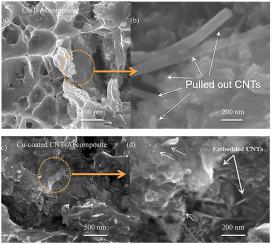Materials Science and Engineering: A ( IF 6.4 ) Pub Date : 2021-01-12 , DOI: 10.1016/j.msea.2021.140765 Pramod Rakt Patel , Sumit Sharma , S.K. Tiwari , Saurabh Kango

|
Aluminium (Al) is one of the most widely used matrix material for making lightweight composite materials for structural applications. Though a number of studies have been conducted on carbon nanotube (CNT) reinforced Al composites but the problem of agglomeration of CNTs and a decrease in ductility still remain to be solved. In this study, a novel strategy has been suggested for making high-strength and high ductility CNT reinforced Al composites. The pristine CNTs were first coated with copper (Cu) before being added into the Al matrix. The composites were prepared using spark-plasma sintering and hot-rolling. SEM, TEM, XRD and EBSD studies were conducted on the prepared samples to characterize the microstructures. A coherent interfacial Cu region was formed between the CNTs and the Al matrix. This interfacial region resulted in an improvement in both the tensile strength as well as ductility. The tensile strength of the Cu-coated CNT reinforced Al composites was found to be 360 MPa, greater by 90 MPa in comparison to the un-coated CNT reinforced Al composites. In comparison to pure Al, the Cu-coated CNT reinforced Al composites showed an improvement of 175 MPa in yield strength while still maintaining a high ductility value of 15%. This is in stark contrast to the inverse relation between ductility and strength which holds for structural materials. The interfacial load transfer was better in the Cu-coated CNT-Al composites in comparison to the un-coated CNT-Al composites.
中文翻译:

改性界面性能改善碳纳米管增强铝纳米复合材料的拉伸强度和延展性
铝(Al)是用于制造轻质复合材料以用于结构应用的最广泛使用的基体材料之一。尽管已经对碳纳米管增强的铝复合材料进行了许多研究,但是碳纳米管的团聚和延展性降低的问题仍然有待解决。在这项研究中,提出了一种新的策略来制造高强度和高延展性的CNT增强Al复合材料。原始的CNT首先被铜(Cu)覆盖,然后再添加到Al基体中。使用火花等离子体烧结和热轧制备复合材料。对制备的样品进行了SEM,TEM,XRD和EBSD研究,以表征其微观结构。在CNT与Al基体之间形成了相干的界面Cu区域。该界面区域导致抗张强度和延展性的改善。发现铜涂覆的CNT增强的Al复合材料的拉伸强度为360MPa,与未涂覆的CNT增强的Al复合材料相比,抗拉强度提高了90MPa。与纯铝相比,镀铜的碳纳米管增强铝复合材料的屈服强度提高了175 MPa,同时仍保持了15%的高延展性。这与延展性和强度之间的反比关系形成了鲜明的对比,这种反比关系对结构材料而言是成立的。与未涂覆的CNT-Al复合材料相比,Cu涂覆的CNT-Al复合材料的界面载荷传递效果更好。与未涂覆的CNT增强的Al复合材料相比,其抗压强度提高了90 MPa。与纯铝相比,镀铜的碳纳米管增强铝复合材料的屈服强度提高了175 MPa,同时仍保持了15%的高延展性。这与延展性和强度之间的反比关系形成了鲜明的对比,这种反比关系对结构材料而言是成立的。与未涂覆的CNT-Al复合材料相比,Cu涂覆的CNT-Al复合材料的界面载荷传递效果更好。与未涂覆的CNT增强的Al复合材料相比,其抗压强度提高了90 MPa。与纯铝相比,镀铜的碳纳米管增强铝复合材料的屈服强度提高了175 MPa,同时仍保持了15%的高延展性。这与延展性和强度之间的反比关系形成了鲜明的对比,这种反比关系对结构材料而言是成立的。与未涂覆的CNT-Al复合材料相比,Cu涂覆的CNT-Al复合材料的界面载荷传递效果更好。



























 京公网安备 11010802027423号
京公网安备 11010802027423号